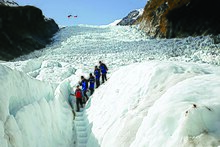Heli hiking

Heli hiking is a
Heli hiking is a form of mountain recreation in the mountainous regions of New Zealand and the Bugaboos in Canada.[7][8] It is a form of glacier tourism in locations including Glacier Bay National Park, Westland Tai Poutini National Park, and Ilulissat Icefjord.[9]
History
The first heli hiking tour took place in the summer of 1978 at the Cariboo Lodge, operated by Canadian Mountain Holidays.[10] It was introduced as and continues to be the summer counterpart to heli skiing.[10]
Marketing
Heli hiking has been marketed toward women.[11] It is popular among young female tourists in New Zealand.[12]
The activity is advertised as a luxury tourist attraction.
Environmental impact and regulation
Due to the disturbances caused by helicopter overflights, heli hiking is considered by authorities to be a possible cause of the decline of the mountain goat population in southeastern British Columbia and is opposed by the East Kootenay Environmental Society.[13][14][1] It has also impacted British Columbia's Graham caribou population through displacement and interruption of migratory cycles.[15]
In the North Cascades, heli hiking has been discouraged by the United States Forest Service.[16] However, there is still minimal regulation of heli hiking and other mountain recreation activities for environmental protection.[4]
References
- ^ ISSN 0261-5177.
- ^ Thirkell, K. (1999). View from the top. The Ottawa Citizen, October 2, K1.
- ^ Shephard, Graham, and Sarah Evans. "Adventure tourism–hard decisions, soft options and home for tea: adventure on the hoof." Niche Tourism. Routledge, 2007. 210-218.[1]
- ^ S2CID 154778170.
- JSTOR 3673142.
- ISSN 0160-7383.
- S2CID 131002782.
- ^ Moure, Celeste. "Heli-Hiking in the Canadian Rockies". National Geographic. Archived from the original on October 2, 2016.
- ISSN 2212-571X.
- ^ ISBN 978-1-78064-460-8.
- ISBN 978-1-4262-0051-9.
- ISBN 978-1-136-47563-4.
- S2CID 85774284.
- ^ Poole, K. G., and Ian Adams. "Mountain goat monitoring in Canadian Mountain Holidays’ Bugaboo and Bobbie Burns heli-hiking areas, East Kootenay, September 2002." Unpublished report for Canadian Mountain Holidays, Cranbrook British Columbia (2002).
- ^ Culling, Diane E., and Brad A. Culling. SEASONAL HABITAT USE AND MOVEMENTS OF GRAHAM CARIBOU 2001 to 2003. http://www.env.gov.bc.ca/wildlife/wsi/reports/4552_WSI_4552_RPT_2001-2003.PDF
- ^ Burr, Eric. "Heli-Ski Survival Guide." https://arc.lib.montana.edu/snow-science/objects/issw-1996-207-208.pdf
